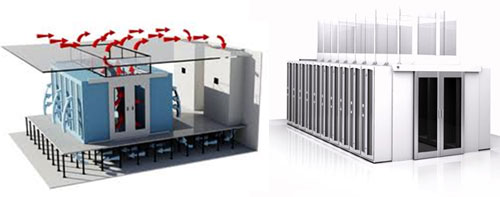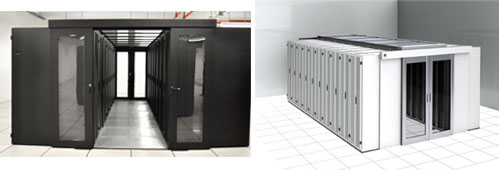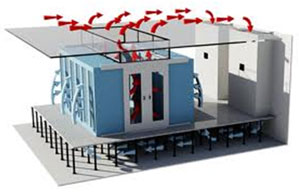Passive Cooling in Data Centers
Hot Aisle and Cold Aisle Containment Strategies
Based on the typical layout of alternating aisles of equipment faces, a popular air isolation strategy is to focus on enclosing or containing the aisles, however, there has been considerable debate and discussion on whether it is the hot aisle or the cold aisle that should be contained.
In hot aisle containment, (HAC) cool supply air is directed to the front of the computer equipment, or the cool aisle, while the back of the equipment faces the “hot” aisle. In this strategy, it is this hot aisle that is enclosed or contained by doors at either end. In the ideal design scenario, the cool supply air is drawn up through the floor plenum in front of the equipment and pulled through the cabinet or rack over the computer equipment to pick up the unwanted heat. It now becomes return air that enters the enclosed hot aisle where it is captured. Since this hot aisle is also isolated from the top of the equipment up to an open ceiling plenum, it then returns back to the CRAC to be treated and the cycle repeats as needed. Under this strategy, the room itself is the area that receives the cool supply air and the hot air is isolated and returned. To the degree that cabling and other maintenance work will be done in the rears of cabinets, the HAC will create a relatively inhospitable working environment of 95 °F – 130 °F.
 |
Hot Aisle Containment (HAC) isolates the hot aisle, captures the hot exhaust air from IT equipment and directs it back to the CRAC/CRAH, keeping it segregated from the cold air. Images courtesy of Chatsworth Products, Inc. |
In the cold air containment (CAC) strategy, the approach is reversed. Here, the cold aisle is enclosed or contained with solid doors and a containment ceiling to separate it from the rest of the room. In this case, the cool supply air enters again ideally through the floor plenum and is drawn through the racks or cabinets of computer equipment. As it picks up the heat and exits out the rear, it enters the room and is drawn back, typically below the room ceiling, to the CRAC. The enclosure is essentially the same on either end of the aisle between the hot air and cold air containment strategies. The difference is that a ceiling enclosure is needed in the cold air containment strategy to create the open air space between the top of the computer equipment and the room ceiling hence the warmed return air is not captured, but released into the room. The raised floor becomes the important design feature to deliver the cool supply air and create the air isolation. Cold aisle containment is typically superior for retrofitting existing spaces because it is easier to avoid overhead obstructions such as cable pathway or power distribution busway and, as noted below, has been demonstrated to provide longer thermal ride through in higher density applications. Unfortunately, the remaining non-contained area of the data center becomes the “hot aisle” and will subject workers to temperatures ranging from 95 °F – 130 °F.
 |
|
Cold Aisle Containment (CAC) isolates the cold air, preventing it from mixing with the hot air in an entirely closed off area targeted at cooling equipment instead of the room. Images courtesy of Chatsworth Products, Inc. |
 |
A recently published (2011) paper by Dr. Rainer Weldmann of T-Systems International and Dr. Markus Leberecht of Intel focused on the differences between efficiencies and energy performance of both hot air and cold air containment strategies. Under the banner of joint project between their companies known as Data Center 2020, they have previously looked at the specifics of air isolation including detailed investigations of hot air and cold air containment. The results of their research have affirmed that the strict separation of cold and hot air in raised floors and contained aisles optimizes air flow and minimization of leakage and mixing, which also reduces the fan speed of the CRAH units. They have also shown that raising the supply air temperature delivered along with raising the chilled water temperature minimizes the hours required for cooling by the chillers and extends the hours available for economizer (free) cooling. They have further investigated multiple ways to vary conditions and achieve the best energy performance and efficiencies. All else being equal, they have concluded that there are no significant differences between the efficiencies of hot aisle and cold aisle containment systems. Contrary to conventional wisdom, they did find, however, that HAC provided more thermal ride-through time in the event of catastrophic cooling failure than CAC for lower density cabinets, while CAC provided more time for higher density cabinets (17kW). Nonetheless, properly designed, either one can be expected to provide reasonably good and similar performance, particularly when compared to traditional open air systems.









